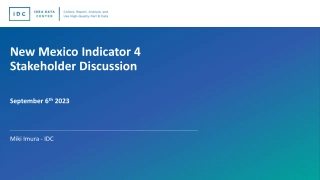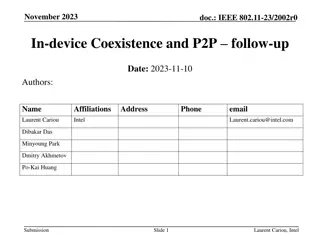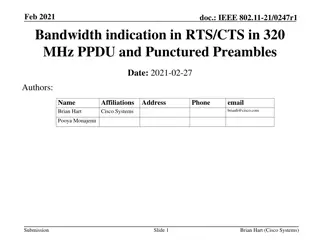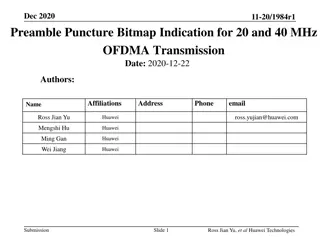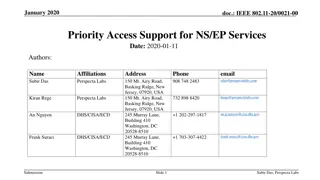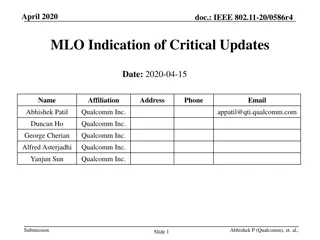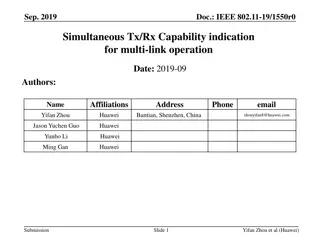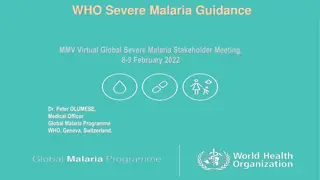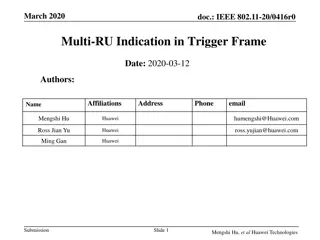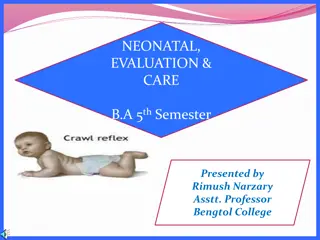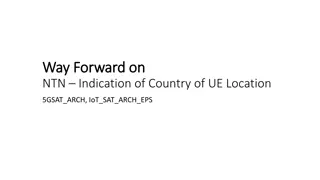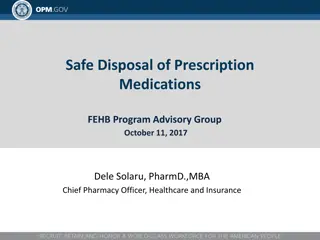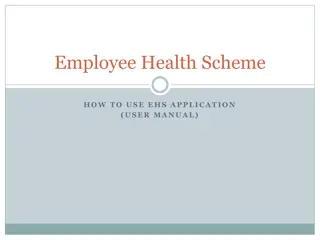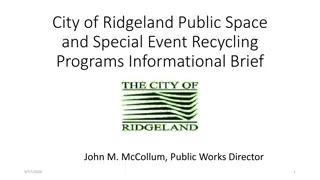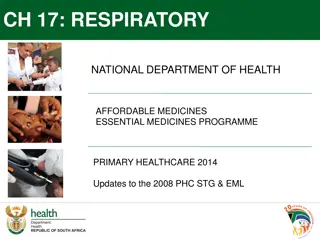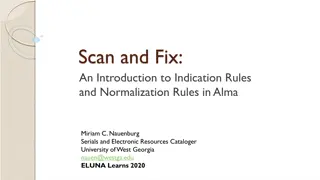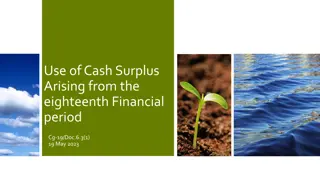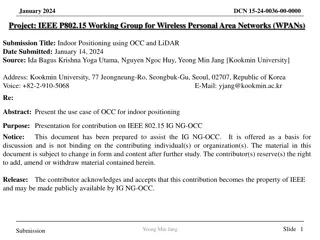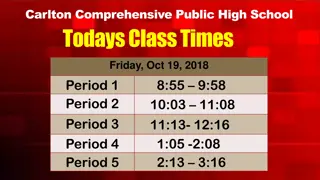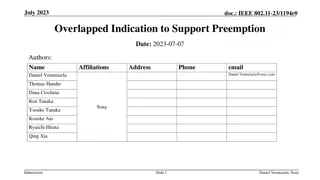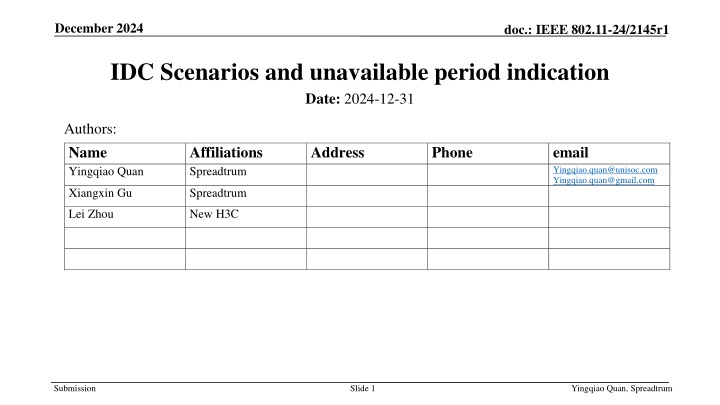
IEEE 802.11-24/2145r1 - Unavailability Information Indication Scenarios
Explore the scenarios and challenges related to indicating unavailable periods in IEEE 802.11-24/2145r1 documentation. Discover the current designs, options, and considerations for unsolicited unavailability information indication, along with insights on dealing with unpredictable IDC events during a TXOP. Learn about a potential solution involving a new (A-)control field for IDC information and how it could streamline signaling overhead.
Download Presentation

Please find below an Image/Link to download the presentation.
The content on the website is provided AS IS for your information and personal use only. It may not be sold, licensed, or shared on other websites without obtaining consent from the author. If you encounter any issues during the download, it is possible that the publisher has removed the file from their server.
You are allowed to download the files provided on this website for personal or commercial use, subject to the condition that they are used lawfully. All files are the property of their respective owners.
The content on the website is provided AS IS for your information and personal use only. It may not be sold, licensed, or shared on other websites without obtaining consent from the author.
E N D
Presentation Transcript
December 2024 doc.: IEEE 802.11-24/2145r1 IDC Scenarios and unavailable period indication Date: 2024-12-31 Authors: Name Yingqiao Quan Affiliations Spreadtrum Address Phone email Yingqiao.quan@unisoc.com Yingqiao.quan@gmail.com Xiangxin Gu Spreadtrum Lei Zhou New H3C Submission Slide 1 Yingqiao Quan, Spreadtrum
December 2024 doc.: IEEE 802.11-24/2145r1 Background Unavailability information could be used for Co-ex and even for power save. TGbn has passed several motions on TXOP level unavailability information indication and we have following items in SFD [1] [2] : [Motion #30] 11bn defines a mechanism for a non-AP STA to report unavailability at TXOP level and define or reuse/update existing mechanism for a non-AP STA to report long term (periodic) unavailability. [Motion #146] A non-AP STA that is a TXOP responder can indicate in a response frame 1) for how long it will be available, if known and/or 2) whether it will be unavailable after a specific point in time and, if known, for how long. The response frame is a multi-STA BlockAck frame sent by the non-AP STA in response to the initial control frame or to MPDUs that solicit an immediate response. Currently, we haven't reached a consensus on the unsolicited unavailability indication yet. Submission Slide 2 Yingqiao Quan, Spreadtrum
December 2024 doc.: IEEE 802.11-24/2145r1 Current designs For unsolicited unavailability information indication, there might be two options at present. Multi-STA BA [3] and [4] . BSRP TF [5] . Both of them need to change aggregation rules in some cases. A QoS-Null data frame with BSR and a multi-STA Block ACK frame with unavailability information will be aggregated in an A-MPDU as a response in a TB PPDU for the BSRP TF [6]. Both of them may not be acknowledged to make sure the peer get the information. Unless the response rules are changed or newly defined. Submission Slide 3 Yingqiao Quan, Spreadtrum
December 2024 doc.: IEEE 802.11-24/2145r1 Unpredictable IDC events during a TXOP It might be possible that a non-AP STA is aware of an upcoming IDC event after responding to an ICF or initiating a TXOP. For some instances: Game player s control information delivered through in-device Bluetooth. In general, the event can be indicated to Wi-Fi about 0.5 ms in advance. UL transmission scheduled by gNB can be known about 1 ms in advance. Such IDC events are unpredictable and may overlap with the remnant TXOP . Report them in ICR might be impossible sometime. Submission Slide 4 Yingqiao Quan, Spreadtrum
December 2024 doc.: IEEE 802.11-24/2145r1 Unavailable period indication by (A-)control field [7] has mentioned that a new (A-)control field for IDC Info can be included in QoS Data/Null frames, Management frames (similar to BSR). Indicating unavailable period by A-control field might be an alternative option for both solicited or unsolicited case. Can be piggybacked in QoS Data/Null frames and Management frames. Easier to indicate a sudden IDC event during a TXOP. The aggregation rules needn t to be changed. Unavailability information delivered in A-Control subfield in a frame can be ACKed. May reduce signaling overhead. Submission Slide 5 Yingqiao Quan, Spreadtrum
December 2024 doc.: IEEE 802.11-24/2145r1 Unavailable period indication (UPI) by (A-)control field There are two options for unavailable period indication by A-control field: Opt1. use TBD bits to indicate unavailability duration. Imply that the unavailability duration will start after this PPDU or the response PPDU of this PPDU. Opt2. use TBD1 bits to indicate unavailability start time and TBD2 bits duration. TBD1 and TBD2 can be 9 [5] [8]. Unavailability duration Unavailability start time Unavailability duration Control ID Control ID 4 bits The name of such A-control is TBD (e.g. UPI control) TBD bits 4 bits TBD1 bits TBD2 bits Submission Slide 6 Yingqiao Quan, Spreadtrum
December 2024 doc.: IEEE 802.11-24/2145r1 Cross link Unavailable period indication [9] proposed Multi-link unavailability indication (MLUI) by which unavailable period can be indicated cross links. A 4 bits Link ID can be added in the UPI control field (name TBD) to indicate the unavailable period of a specific link. Control ID Unavailability duration Control ID Unavailability start time Unavailability duration Link ID Link ID 4 bits 4 bits TBD bits 4 bits 4 bits TBD1 bits TBD2 bits Submission Slide 7 Yingqiao Quan, Spreadtrum
December 2024 doc.: IEEE 802.11-24/2145r1 Summary This document analyzed requirements of unpredictable IDC events and proposed to use A- Control field for the unavailable period indication. Submission Slide 8 Yingqiao Quan, Spreadtrum
December 2024 doc.: IEEE 802.11-24/2145r1 SP 1 Do you agree to add the following text to the 11bn SFD? A non-AP STA can indicate in A-Control subfield 1) for how long it will be available, if known and/or 2) whether it will be unavailable after a specific point in time and, if known, for how long. Submission Slide 9 Yingqiao Quan, Spreadtrum
December 2024 doc.: IEEE 802.11-24/2145r1 References [1] 11-24-0171-21-00bn-tgbn-motions-list-part-1 [2] 11-24-0209-07-00bn-specification-framework-for-tgbn [3] 11-24-1550-01-00bn-in-device-coexistence-follow-up [4] 11-24-1558-02-00bn-in-device-coexistence-follow-up [5] 11-24-1893-00-00bn-icf-follow-up [6] 11-24-1887-00-00bn-bsrp-tf-response-rules-changes-for-m-ba [7] 11-24-0834-01-00bn-some-details-on-in-device-coexistence [8] 11-24-1974-03-00bn-detailed-text-proposal-on-coexistence [9] 11-24-0806-00-00bn-multi-link-in-device-coexistence-management Submission Slide 10 Yingqiao Quan, Spreadtrum

